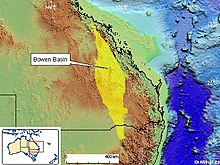Bowen cymbals

The Bowen Basin (English: Bowen Basin ) originated from Permian to Middle Triassic in Queensland , Australia . The sedimentary basin extends over an area of 60,000 km². The most important coal and natural gas reserves in Australia are located in this area . Ludwig Leichhardt , a German explorer, was the first European to find coal deposits in Bowen Basin when he was on his first voyage of discovery from Port Essington to the Northern Territory from 1844 to 1855 .
The Bowen Basin is part of the greater Sydney - Gunnedah -Bowen Basin.
geology
In the south, the Bowen Basin is half covered by the Surat Basin . The sedimentation layers in the northern section, from both the Taroom Trough (east) and the Denison Trough (west), reach a maximum thickness of more than 10,000 meters. The deposits formed in the early Permian from sedimentation of rivers, inland lakes and volcanic events, all of which were deposited in layers in a ditch in the east, while coal and non-marine sediments accumulated in the west. In a warm phase from the Middle to the Late Permian, further clastic sediments and coal seams formed in estuaries and in shallow water zones. The foreland of this basin expanded from east to west in the late Permian, in which sediments from rivers and lakes as well as coal seams of great thicknesses formed. In the early and middle Triassic there was again sediment formation from rivers and inland lakes. In the north it connects to the Sydney Basin .
Coal deposits
The Bowen Basin contains the largest coal deposit in Australia . It is also the world's largest deposit of bituminous coal. It ranges from Collinsville to Theodore . Over 100 coal deposits have been discovered, of which 34 coal mines currently extract around 100 million tons annually. Bituminous coal is of higher quality than lignite , while the anthracite coal is of higher quality than the bituminous coal.
Gas fields
In the north of the basin, large volumes of methane gas formed in shallow waters from the Permian coal deposits . Two forms of natural gas that are used economically occur in the underground gas fields : natural gas and coal seam methane (CSM). The main component of both gases is methane .
Natural gas is a combustible natural gas. It often occurs with petroleum because it is created in a similar way. However, there are no significant oil reserves in Queensland. Natural gases mainly consist of extremely flammable methane, but differ in their chemical composition. The coal seam methane is released by mining and used as fuel.
Fairview gas field
The Fairview gas field extends over a field of 5,000 km² approximately 500 to 600 km northwest of Brisbane and 100 to 200 km north of Roma and is connected to Wallumbilla by an approximately 130 km pipeline .
Scotia gas field
The Scotia gas field is located approximately 340 km northwest of Brisbane and 145 km northeast of Roma. The gas is transported in a 111 km pipeline from Scotia to the Roma-Brisbane pipeline.
Web links
Individual evidence
- ↑ http://www.bowenbasin.cqu.edu.au/
- ^ Coal Mining in Blackwater . In: BICC without data
Coordinates: 23 ° 30 ′ 0 ″ S , 148 ° 6 ′ 0 ″ E